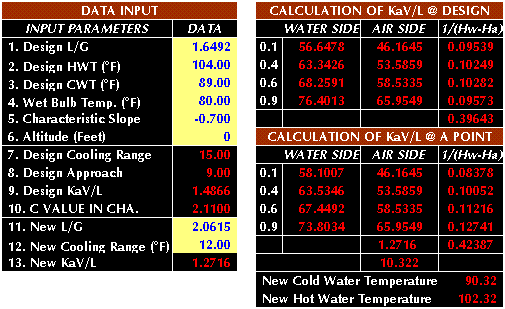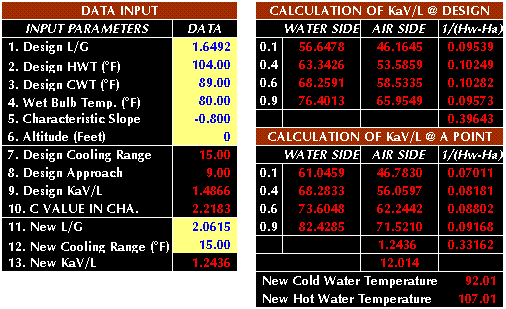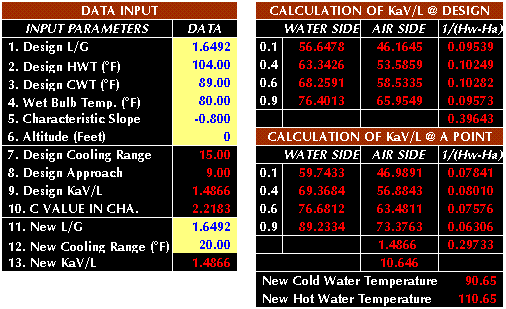| New
Cold Water Temperature = Wet Bulb Temperature + New
Approach

Fifth Step: Compute
the cold water temperature with the result of iteration
as follows;
New CWT = WBT + New Approach
= 80 + 10.32 = 90.32oF
New HWT = CWT + Range = 90.32 + 12 = 102.32oF
Through this example, it
was proven that the cold water temperature at the slope
of - 0.7 is slightly lower than - 0.13.
Example 4-3.
The example number 18 was based on the assumption that
the heat load is constant for the increase of water
flow rate. Estimate the cold & hot water temperature
under the assumption that the cooling range is constant
for the increase of water flow rate to 20,000 from 16,000
GPM.
(Solution)
Range, R1 = R2 = HWT - CWT = tw2
- tw1 = 104 - 89 = 15oF
Water Flow Rate in Pound, L1 = Water Flow
Rate x (500 / 60) = 16,000 x (500 / 60) = 133,333.3
lb/min
Heat Load, D1 = L1 x R1
= 133,333.3 x 15 = 2,000,000 BTU/min
Air Mass Flow Rate, G1 = G2 =
80,848 lb/min
Liquid to Gas Ratio, L/G1 = L1
/ G1 = 133,333.3 / 80,848 = 1.6492
Water Flow Rate in Pound, L2 = Water Flow
Rate x (500 / 60) = 20,000 x (500 / 60) = 166,666.7
lb/min
Heat Load, D2 = L2 x R2
= 166,666.7 x 15 = 2,500,000 BTU/min
Liquid to Gas Ratio, L/G2 = L2
/ G2 = 166,666.7 / 80,848 = 2.0615
The value of NTU at the
design conditions is same as a value calculated in the
example 4-1. The value of "C" of tower characteristic
for the design conditions same as the example 4-1. The
new tower characteristic for the increased water flow
is also same as the example 4-1. Iterate until the value
of new characteristic is equal to the new NTU varying
the value of approach.
New Cold Water Temperature
= Wet Bulb Temperature + New Approach

Fifth Step: Compute the cold
water temperature with the result of iteration as follows;
New CWT = WBT + New Approach
= 80 + 12.01 = 92.01oF
New HWT = CWT + Range = 92.01 + 15 = 107.01oF
Example 4-4.
Assume again the conditions of example 4-1 and determine
the cold and hot water temperature when the heat load
is added to increase the cooling range from 15 to 20oF,
assuming no change in the water circulation rate or
in entering air mass flow rate or wet bulb temperature.
(Solution)
Range, R1 = HWT - CWT = tw2 -
tw1 = 104 - 89 = 15oF
Water Flow Rate in Pound, L1 = L2
= Water Flow Rate x (500 / 60) = 16,000 x (500 / 60)
= 133,333.3 lb/min
Air Mass Flow Rate, G1 = G2 =
80,848 lb/min
Liquid to Gas Ratio, L/G1 = L1
/ G1 = L/G2 = 133,333.3 / 80,848
= 1.6492
Range, R2 = 20oF
The value of NTU, and "C" at the design conditions
is same as a value calculated in the example 4-1. Also,
the new tower characteristic for even a increased cooling
range is same as the example 4-1. Iterate until the
value of new characteristic is equal to the new NTU
varying the value of approach. (New Cold Water Temperature
= Wet Bulb Temperature + New Approach)

Fifth Step: Compute
the cold water temperature with the result of iteration
as follows;
New CWT = WBT + New Approach
= 80 + 10.65 = 90.65oF
New HWT = CWT + Range = 90.65 + 20 = 110.65oF
Example 4-5. Assume
the existing mechanical-draft cooling tower is operating
at the initial conditions of example 4-1. Determine
the cold & hot water temperature if the air mass
flow rate is reduced to 53,900 lb/min by the adjustment
of the fan pitch angle and/or fan speed.
To be continued. Please press the next button.... |